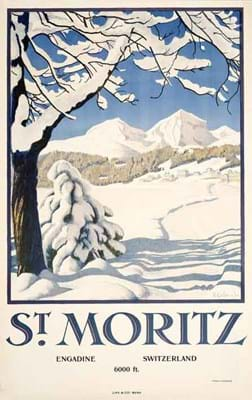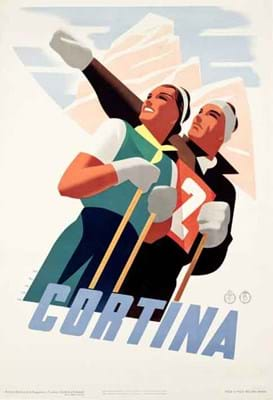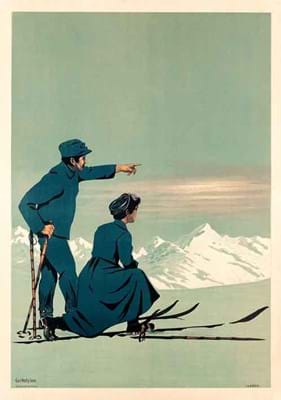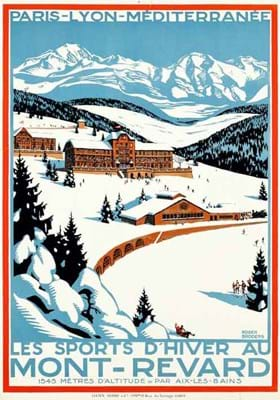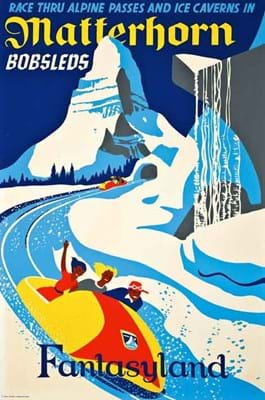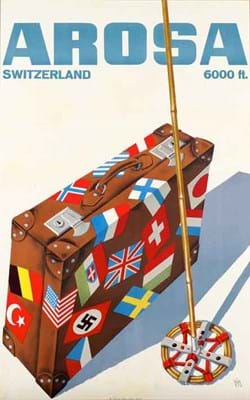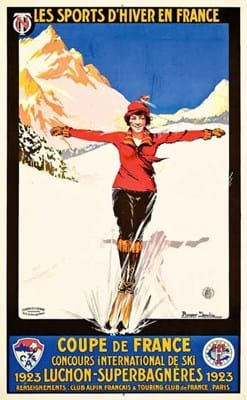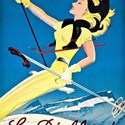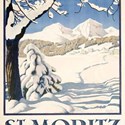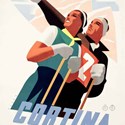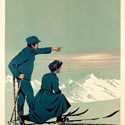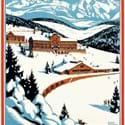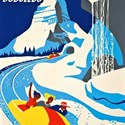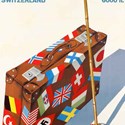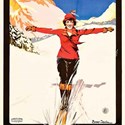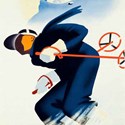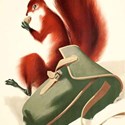It is fuelled by nostalgia and the current vogue for large framed vintage posters seen in trendy homes, offices and, in this case, also chalets. And it is a market that keeps on giving.
"Since we started the ski sale the market has certainly opened up," said Ms Tomkinson. "We have seen more interior designers and decorators participate at these sales as well as a broader pool of private clients."
As the ski sale has become more established, word of mouth has also played its part. "Someone might have seen a poster on a friend's wall and wondered where they could get one," said Ms Tomkinson.
As the sale-type is unique to Christie's, they tend to get the pick of what is available, with consignments split roughly half and half between the trade and private collectors.
Ski posters were originally produced by resorts using some of the top artists of the day to entice the wealthy to spend their winter holidays on the slopes. When the season ended, they were often ripped down from railway stations, travel agents and billboards and thrown away. The fact that so few have survived adds to their value and attraction.
Resort Status
In general, a poster with plenty of decorative appeal showcasing a prestigious resort, such as a Swiss or French one, will be the most sought-after. Often style, rarity, artist and condition are of secondary importance to the buyer.
Yet, as is the case with many collectors, they choose to buy simply because they love a particular poster, and as long as they are stored away from direct sunlight and behind UV-screening glass - ideally attached to acid-free cloth - buyers should also have an appreciating asset.
The latest ski sale, held on January 23 at Christie's South Kensington, took place amid suitably wintry conditions, and bidders did not disappoint. Just 18 lots of the 161 on offer were left unsold (a success rate of 89%) to total £552,400, nearly matching last year's much larger 245-lot sale that netted a shade under £590,000.
Bids came from the room and the phones and, as in years past, from the ski slopes via mobile phones. They also came from places such as Texas, Oslo, Zurich and Lausanne via the auctioneers' bidding platform, Christie's Live.
Selling rates and prices have climbed consistently in recent years, interrupted only in 2008, when Russian money temporarily caused a spike in prices for posters promoting the Soviet homeland.
This year's average lot price was £3800, a £1200 increase on last year. That said, prices for individual posters can fluctuate from one sale to the next depending on the whims of bidders.
For instance, last year a 1920s design for the Palace Hotel, St Moritz by Emil Cardinaux, one of the best-known artists in this field, fetched twice its bottom estimate at £20,000; this year's example, catalogued as in the same condition and with the same guide price, sold for £9000. Such unpredictability is a good reason for Christie's to keep a lid on estimates as they do.
Swiss posters continued their dominance at the top end, accounting for 74 lots in the sale and contributing around £250,000 of the total. The remaining posters were shared between resorts in France, Italy, Scandinavia, Germany, Austria, Russia and North America, as well as a few Alpine-themed commercial posters.
The sale also included 20 lots of period Louis Vuitton luggage offered for the first time in the ski sale.
Typical of the prices paid for the best posters in this field was the sale's top lot. Designed by Swiss artist Plinio Colombi (1873-1951), it included plenty of deep crisp white snow, a cloudless blue sky and St Moritz in large bold writing.
Measuring 3ft 4in x 2ft 1in (1.03m x 65cm), the lithograph was produced in 1929 by Lips & Co, Bern, and was condition grade A- (A being the optimum condition through to C needing restoration). It sold for £20,000 after two phones took it beyond the £10,000-15,000 guide. The successful phone bidder was active throughout the sale and made a number of other high-end purchases.
Davos
Swiss resorts such as Klosters, Gstaad, Zermatt and Davos didn't come into their own until the 1930s, but they had been functioning well before then. The pre-'30s posters that survive tend to do well in the saleroom and sometimes fetch meatier prices than later posters.
A case in point was a c.1910 poster for Davos featuring skiers taking a break from their strenuous activity to enjoy the view. Measuring 3ft 3in x 2ft 3in (1m x 70cm), three telephones pursued it above the 3000-5000 estimate to £8000 - the top price in the seven-lot Davos section.
Les Diablerets
A poster by Martin Peikert (1901-75) promoting the village and ski resort of Les Diablerets in the canton of Vaud in Switzerland also proved popular. Depicting a young blonde hitching a ride on a chair lift with a small child on her shoulders playing a pipe and wearing skis, the 3ft 4in x 2ft 1in (1.02m x 64cm), the condition B+ lithograph took over three times its top estimate at £9400, selling to a phone bidder.
Mont-Revard
The 34 lots of French posters contributed over £100,000, with a good take-up for one of the best-known poster artists, Roger Broders (1883-1953). Last year's ski sale broke the record for a work by the artist at auction when a winter sports scene for the resort of St Pierre de Chartreuse sold for £26,000.
However, Broders works still come at accessible prices, with his cheapest design in this year's sale going for just £1200. Mont-Revard, pictured in the slideshow on this page, measures 3ft 6in x 2ft 7in (1.07m x 78cm) and is in condition B. It improved on its £2000-3000 estimate to sell at £3500.
Cortina
Beyond Swiss and French highlights, Italian ski posters produced the most competitive bidding. The five-lot group included a popular design by Mario Puppo (1905-77) promoting the Northern Italian resort of Cortina.
The 3ft 3in x 2ft 3in (1m x 69cm) lithograph of two tanned skiers smiling into the distance was dated to 1938 and sold for £11,000 against a £4000-6000 estimate.
The buyer's premium was 25/20/12%


